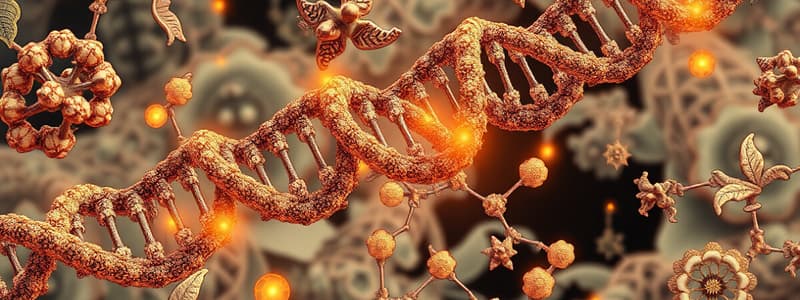Podcast
Questions and Answers
A nucleotide is made up of which of the following components? (Select all that apply)
A nucleotide is made up of which of the following components? (Select all that apply)
- A nitrogenous base (correct)
- A phosphate group (correct)
- An amino acid
- A pentagon-shaped sugar (correct)
Where is the phosphate group of a nucleotide found?
Where is the phosphate group of a nucleotide found?
5' carbon
What is the difference between the 5-carbon sugars of DNA and RNA?
What is the difference between the 5-carbon sugars of DNA and RNA?
RNA has 2 hydroxyl groups at the 2' and 3' carbons
Which nucleic acid contains thymine?
Which nucleic acid contains thymine?
Which nucleic acids contain a phosphate group?
Which nucleic acids contain a phosphate group?
Which nucleic acid contains ribose?
Which nucleic acid contains ribose?
Which nucleic acid contains uracil?
Which nucleic acid contains uracil?
Which nucleic acid contains deoxyribose?
Which nucleic acid contains deoxyribose?
Which nucleic acid is normally double stranded?
Which nucleic acid is normally double stranded?
Which nucleic acid is normally single stranded?
Which nucleic acid is normally single stranded?
Why are DNA sugars called deoxyribose?
Why are DNA sugars called deoxyribose?
What are the components of a nucleotide?
What are the components of a nucleotide?
What does DNA stand for?
What does DNA stand for?
What is the main purpose of DNA?
What is the main purpose of DNA?
What is the sugar in DNA?
What is the sugar in DNA?
What are the subunits that make up DNA?
What are the subunits that make up DNA?
What is a purine?
What is a purine?
What are the two purines?
What are the two purines?
Who made the structure of DNA?
Who made the structure of DNA?
How did Rosalind Franklin contribute to determining the structure of DNA?
How did Rosalind Franklin contribute to determining the structure of DNA?
What types of bonds hold DNA together?
What types of bonds hold DNA together?
What makes up the backbone of DNA?
What makes up the backbone of DNA?
What was Phoebus Levene's contribution to the discovery of DNA?
What was Phoebus Levene's contribution to the discovery of DNA?
What was Fredrick Griffith's contribution to the discovery of DNA?
What was Fredrick Griffith's contribution to the discovery of DNA?
What was Avery, MacLeod, and McCarty's contribution to the discovery of DNA?
What was Avery, MacLeod, and McCarty's contribution to the discovery of DNA?
What was Alfred Hershey and Martha Chase's contribution to the discovery of DNA?
What was Alfred Hershey and Martha Chase's contribution to the discovery of DNA?
What was Erwin Chargaff's contribution to the discovery of DNA?
What was Erwin Chargaff's contribution to the discovery of DNA?
What was Maurice Wilkin's contribution to the discovery of DNA?
What was Maurice Wilkin's contribution to the discovery of DNA?
What was Watson and Crick's contribution to the discovery of DNA?
What was Watson and Crick's contribution to the discovery of DNA?
Flashcards are hidden until you start studying
Study Notes
Nucleotide Structure
- A nucleotide consists of a phosphate group, a pentose sugar, and a nitrogenous base.
- The phosphate group is attached to the 5' carbon of the sugar.
Differences Between DNA and RNA
- DNA contains deoxyribose sugar; RNA contains ribose sugar with hydroxyl groups at the 2' and 3' carbons.
- DNA includes the nitrogenous base thymine (T); RNA includes uracil (U).
- DNA is typically double-stranded, while RNA is usually single-stranded.
Sugar Characteristics
- Deoxyribose lacks a hydroxyl group on the 2' carbon, whereas ribose has a hydroxyl group on the 2' carbon.
Base Characteristics
- Thymine (T) and cytosine (C) are pyrimidines; adenine (A) and guanine (G) are purines.
- Adenine (A) forms 2 hydrogen bonds with thymine (T) and 2 with uracil (U); cytosine (C) and guanine (G) form 3 hydrogen bonds with each other.
DNA/RNA Processes
- Replication is the process of DNA making a copy of itself.
- Transcription refers to RNA synthesis from a DNA template.
- Translation describes the synthesis of proteins based on RNA instructions.
Key Discoveries in DNA Research
- Phoebus Levene identified nucleotide components: base, sugar, and phosphate group.
- Frederick Griffith demonstrated heredity principles using Streptococcus pneumonia.
- Avery, MacLeod, and McCarty showed that DNA acts as the transforming agent in heredity.
- Hershey and Chase confirmed DNA injection by T4 bacteriophage into host bacteria.
- Erwin Chargaff discovered base pair equivalency ratios (A=T, C=G).
- Rosalind Franklin obtained high-quality X-ray diffraction images of DNA's structure.
- Watson and Crick are credited with building the model of DNA's double helix structure.
Structural Components of DNA
- DNA stands for deoxyribonucleic acid.
- The primary function of DNA is to store genetic information in chromatids.
- The backbone of DNA is made up of sugar and phosphate groups.
- Hydrogen bonds hold the base pairs of DNA together.
Summary of DNA Composition
- DNA comprises the nitrogenous bases adenine (A), thymine (T), cytosine (C), and guanine (G).
- The subunits of DNA include a nitrogenous base, pentose sugar, and a phosphate group.
- Purines are double-ringed nitrogenous bases, specifically adenine (A) and guanine (G).
Historical Contributions
- Watson and Crick are recognized for confirming DNA’s double-helix structure.
- Rosalind Franklin contributed by providing X-ray images aiding in the understanding of DNA structure.
Studying That Suits You
Use AI to generate personalized quizzes and flashcards to suit your learning preferences.


